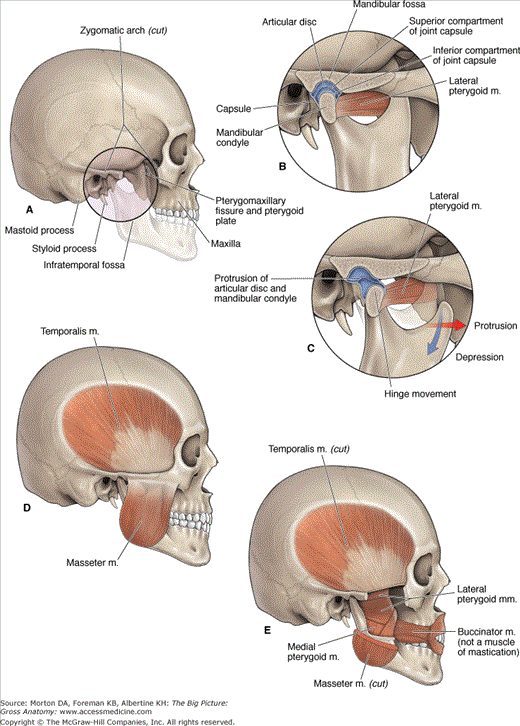Overview of the Infratemporal Fossa
The infratemporal fossa is the region deep to the ramus of the mandible. The infratemporal fossa accommodates the insertion of the temporalis muscle, medial and lateral pterygoid muscles, mandibular nerve [cranial nerve (CN) V-3], otic ganglion, chorda tympani nerve, maxillary artery, and the pterygoid plexus of the veins.
The infratemporal fossa has the following boundaries (Figure 21-1A):
- Deep to the zygomatic arch.
- Anterior to the mastoid and styloid processes of the temporal bone.
- Posterior to the maxilla.
- Medial to the ramus of the mandible.
- Lateral to the pterygoid plate and the pterygomaxillary fissure, a communication between the infratemporal fossa and the pterygopalatine fossa.
Temporomandibular Joint
The articulations between the temporal bone (mandibular fossa) and the mandibular condyle form a synovial joint, known as the temporomandibular joint (TMJ).
The left and right TMJ’s work together, enabling the mandible to move as follows:
- Elevation (up). Generated by the temporalis, masseter, and medial pterygoid muscles.
- Depression (down). Generated by the digastricus, geniohyoid, and mylohyoid muscles, and assisted by gravity.
- Protraction. Generated primarily through the lateral pterygoid muscle. Involves the anterior movement of the mandibular condyle and the articular disc.
- Retraction. Generated by the geniohyoid, digastricus, and temporalis muscles.
- Side-to-side. Generated by the pterygoid muscles.
A unique feature of the TMJ is the fibrocartilaginous articular disc, located within the joint capsule between the mandibular fossa and condyle. The disc divides the joint capsule into two distinct compartments.
- Inferior compartment. Enables the hinge-like rotation of the mandibular condyle, corresponding to the first 2 cm of opening the mouth (depression) (Figure 21-1B).
- Superior compartment. For the mouth to be opened more than 2 cm, the superior compartment within the joint capsule enables both the mandibular condyle and the articular disc to slide anteriorly (protrusion), incorporating a translational movement anteriorly when opening the mouth wider (Figure 21-1C).
 TMJ disorder is associated with painful and limited movement of the jaw. The disorder is poorly understood because of the complexity of the TMJ, which incorporates hinge-like movements along with movements that slide anteriorly and from side to side. Symptoms of TMJ disorder include pain and tenderness in and around the jaw, difficulty and painful chewing, headache, and clicking sounds when the jaw opens and closes. TMJ disorder can occur when the articular disc is damaged, eroded, or has slipped out of alignment.
TMJ disorder is associated with painful and limited movement of the jaw. The disorder is poorly understood because of the complexity of the TMJ, which incorporates hinge-like movements along with movements that slide anteriorly and from side to side. Symptoms of TMJ disorder include pain and tenderness in and around the jaw, difficulty and painful chewing, headache, and clicking sounds when the jaw opens and closes. TMJ disorder can occur when the articular disc is damaged, eroded, or has slipped out of alignment.
Stay updated, free articles. Join our Telegram channel

Full access? Get Clinical Tree



